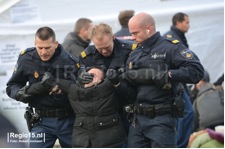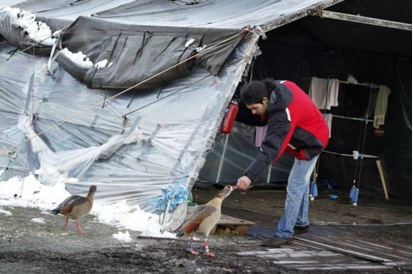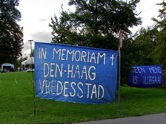Helen Hintjens, from the International Institute of Social Studies (ISS) of Erasmus University Rotterdam, reports from The Hague on the violent eviction of a refugee protest camp.
…we are not people to be pitied, who need to be given shelter. We are demonstrators, who want to get our political message across, by staying visible to the public and to the politicians. (Translated from Dutch, from the Amsterdam De Vluchtkerk website)
The aftermath
On Thursday 13 December 2012, a terrible thing happened in centre of The Hague, the administrative and political capital of the Netherlands. The next morning, Koekamp (Cow Camp), a grassy area near Central Station, bore signs of violence. Police vehicles had gouged deep gashes in the earth; tent poles were bent, cut and lay twisted on the ground. Horses’ hooves criss-crossed the Koekamp, suggesting a battle had been fought here. All this evidence pointed to what had taken place: the rapid and forceful destruction of a refugee protest camp, where for almost three months, from 18 September to 13 December, between forty and eighty protestors had sought the right to remain in safety in the Netherlands. Their demands centred on what they termed the ‘right to exist’ (a literal translation of their website, rechtopbestaan.nl). Many Koekamp protestors were Iraqis, who cannot return to their home country. The battle of the Koekamp was a serious setback for human rights and justice, undermining the claim of The Hague to be an International City of Peace and Justice.[1]
On 12 December, at a court hearing in The Hague, the judge had upheld the demand of the municipality that protestors leave the Koekamp within 48 hours. Earlier, protestors had met and agreed that anyone who wanted to avoid arrest would leave the camp before police closed in to enforce the mayor’s eviction order. Of eighty people in Koekamp tents, more than twenty decided to remain and peacefully resist.

During the night of 12-13 December, a police helicopter circled overhead, a warning that police who patrolled the camp meant business. By lunchtime on the 13th, over 100 police were there and the Koekamp was cordoned off from the public. Protestors and supporters from churches, anti-fascist groups and refugee organisations were arrested and dragged to police vans, one by one (they were released later that day).[2] They chanted ‘No man, no woman, no person is illegal’, and several people who had chained themselves together had to be sawn apart. A video taken from within the cordoned off area shows police using considerable physical force to drag peaceful protestors away (see photo 2). All tents, their contents – blankets, bedding, mattresses, clothing and anything else left behind, were completely destroyed (Photo 1). Two days later, there was nothing left to show that dozens of people had camped here, except bare circles of earth where the tents had been.

BBC News asked Wim Hoonhout, a police spokesman, where the Koekamp refugees were supposed to go. ‘I don’t know’, he replied, ‘they have gone to other places’. They are now dispersed through The Hague. Walking through Koekamp the evening after the eviction, I meet Amin and ask if he has a place to stay. He shrugs as if he does not care, explaining that he is waiting for two young men who had been in the camp, so he can take them to the house of a well-wisher who has offered a place for the night. This camp was a camp for justice and peace, in the city of that name. So what went wrong? Why this battle, and this violence and injustice?
Just days before the battle of the Koekamp, around 100 undocumented protestors and their supporters were evicted from another protest camp at Notweg, in Amsterdam. Both evictions followed court hearings in which judges supported municipal authorities’ eviction orders, and overruled demonstrators’ objections.[3] In Amsterdam, many protestors were Somali; in The Hague, many were Iraqi. At present, neither national group can go home, as it is too dangerous. Yet the Netherlands government refuses to give these people residency rights, the right to work, the right to education if they are over eighteen, and proposes to criminalise all undocumented people. This inhumane treatment affects all undocumented people, especially those who refuse to go home ‘voluntarily’ because they fear the consequences.
Across the EU, tent camp protests are growing. (Read an IRR News story: ‘From despair comes resistance‘) These actions express the desire of refugees, especially those whose asylum claims have been rejected, to act in defence of their own basic human rights. VluchtelingenWerk Nederland, the biggest Dutch refugee support organisation, reports how ‘in the past few years, the tent camps of undocumented failed asylum seekers appear to have grown out of the ground, like mushrooms’. These protests have grown from the spores of systematic injustice and violence, inflicted by European governments on undocumented people. While innocent people from war-torn countries are treated so harshly, there can be no justice and no peace. They face forced destitution, arbitrary detention and forced deportation. And all these policies are based on a logic known as ‘deterrence’. In other words, undocumented people are treated as harshly as possible, not because they have committed any crime, but to ‘convince’ the failed asylum seekers to return to war-torn countries, and to ‘deter’ others at home from trying to come to Europe to seek safety. A policy designed to coerce the innocent cannot be fair or just. And within the limits of the law, undocumented people in Europe have the right to resist such treatment.
Tent camp protests in the Netherlands have seen hundreds of men, women and even children camping out for months on end. The first camps emerged around Ter Appel (a major asylum claims processing centre), and early protests resulted in individuals and families having their asylum claims reconsidered, and gaining the right to remain in the Netherlands. Since then, attitudes of the authorities have hardened, however, and hopes that they might become more generalised have not materialised. The Koekamp protestors hoped their cases would be reconsidered so that justice would be done. Camp protests are an expression of this hope and a certain faith that the Dutch government can still be embarrassed into negotiating peacefully instead of responding with institutionalised violence. The roughness of the recent evictions in the Netherlands suggests instead that failed asylum claimants are treated as a security threat, rather than a human rights issue. Like the UK, the Dutch authorities claim to practice ‘firm but fair’ immigration policies which in reality are cruel and unfair – very far from the lofty ideals of a city of international justice and peace.
The legal case for eviction
‘The tent protest camps are just the tip of the iceberg’, according to VluchtelingenWerk Nederland. They are the visible part of a much deeper problem, a problem that endangers Europe if it continues to be handled with force. The city authorities argued that the tents should be removed because of the potential health risks to occupants – food hygiene, fire safety, and effects on health of cold weather. (Not surprisingly, these claims provoked loud laughter in the court, not shared by the judge.) A similar argument about protecting health had been used to justify the Amsterdam eviction. The judge in The Hague seemed to accept the municipality’s argument that the eviction would protect the protestors’ health and well-being. Yet he surely realised that government policy is to force failed asylum seekers and their families onto the streets, to make them homeless and subject them at any time to arbitrary detention and even where possible, to forced deportation. In The Hague, the undocumented are denied access even to homeless shelters. A second argument made was that the protest camp could not ‘remain indefinitely’, and this may have further persuaded the judge to support the immediate eviction order.
In a passionate speech, the lawyer for the tent-protestors questioned the concern of the municipality for the health and safety of the protestors. Surely, he asked, if camp protestors express their political demands in this particular way, they have the human right to do so. It is a basic human right to engage in collective protest action. By dispersing the tent camp, their existing peaceful and legitimate form of political protest is ended. The lawyer asked the judge to protect the undocumented people’s rights to protest from pseudo-paternalistic protection offered by The Hague municipality in seeking to evict them. He referred to a court decision of mid-September 2012, that Occupy Den Haag could legitimately organise a protest camp on Koekamp. The judge disagreed, however, and in a telling moment, leaned over to ask the protestors’ lawyer whether he felt that the right to protest included the right of a protestor, for instance to set fire to himself or commit public suicide, suggesting that he was uncomfortable with taking the ‘right to protest’ too far. He may have known that some of those involved – Iraqis, Iranians, Somalis – had previously been on hunger strikes, and that protestors had even set fire to themselves or committed suicide, in extreme cases.
The judge’s question suggests a view of the problem that inverts reality as in a distorting mirror. In the protest camp, refugees’ health is protected by their being more visible. This visibility makes them less vulnerable to depression, frustration, to extreme measures like suicide.[4] They are also protected to a greater extent from exploitation and isolation, and from mental health problems, alcohol and other substance abuse. Sharing camp life as a form of protest, in Holland or elsewhere, enables vulnerable individuals to gain courage that they can express hopes and fears they share with others. Their problems are more likely to be reported on, filmed, and understood by the wider society, and thus they gain self-confidence. Under such conditions, the chances that someone will use suicide to protest are minimal. When morale suffers is precisely when asylum seekers are forcibly dispersed, on their own, pushed into dependence on people who may misuse them. Isolation is what can drive undocumented people to take extreme measures, usually in sheer desperation and hopelessness.
The eviction, far from protecting the refugees’ health, put it in jeopardy. Mental health problems, sleeplessness, depression and substance dependence are all likely to increase as a result of trauma caused by the eviction itself. Although police claimed the eviction was peaceful, protestors were injured during the arrests, being dragged away, subjected to physical force, as shown in a film on YouTube,[5] chainsaws used to cut through the tubes and chains linking people burned their arms, and one protestor had a hand broken.
But in the longer term, by pushing protestors back onto the streets, the eviction made their lives much more insecure and dangerous. They became almost as invisible as before the protest started, three months earlier. Perhaps the general public, the media and local and national politicians think the protestors can now be forgotten. They were highly visible for a while, and in the middle of the city. But now they are out of sight, the municipality may feel pleased at having ‘solved the problem’ in time for Christmas and New Year. They managed to throw Koekamp protestors back on the streets, whilst claiming this was done for their own protection. It was quite a feat.
The Hague: International City of Justice and Peace?
Throughout this process, Koekamp protestors and their supporters behaved admirably. They were peaceful, cooperated with the authorities’ requests, met with health inspectors, police, film-makers, journalists, researchers, politicians, students, officials, activists and played host to curious and helpful visitors. Meals were cooked, meetings held, music was played, even the birds were better fed whilst the Koekamp continued (see photo 5). For almost three months, people lived in conditions that were admittedly harsh, but better than being on the streets, alone and homeless in the middle of winter.[6]
The aim of the eviction was to deter future camp protests. Even during the protest, the rule was that tents had to stay open all night long, and in all weather. Police insisted that they should be able to see those inside the tents at all times: each tent had to have see-through plastic sheeting on one side, and a light had to remain on all night. Even the worst refugee camps in Pakistan and Kenya allow refugees to close their tents and get some warmth. Koekamp, with no running water and poor sanitation, became a microcosm of deliberately harsh policies to punish failed refugee applicants across the EU, so as to deter others from joining them. Such cruel regulations were disguised as being vital to the health and safety of the refugees themselves. Even so, life in the camp was decent, clean and peaceful. All the petty regulations could not make life in the Koekamp unliveable. The numbers of protestors increased from forty in September to double that by early December. Protestors fetched water daily, cooked meals, ate together, made decisions in group meetings, prepared for lobbies and protest marches. They wrote letters, were filmed and gave interviews to the media, and kept the camp quiet at night. The camp protest was completely non-violent, and even peaceful and friendly.
Despite recently being acclaimed as a champion of the homeless, the mayor of The Hague, van Aartsen, unlike his counterpart in Amsterdam, did not even offer to shelter the protestors after their eviction, although Joelle Voordewind of the Christian Union Party urged him to do so in early December.[7] He claimed that it was the responsibility of the government, accusing the relevant minister of ‘ostrich-like’ behaviour. The former Secretary of State for Justice, Fred Teeven, retorted that since the Koecamp protest was a ‘public order’ issue, it was the responsibility of the municipality.

Other Dutch municipalities have responded better. In Utrecht, a church organisation for refugees, STIL, working with refugees and migrants without leave to remain, persuaded local municipal authorities to provide some shelter and warmth through winter for some undocumented protestors who had camped out. In Amsterdam too, the mayor offered Notweg camp protestors a month’s shelter, food and warmth. Eventually this offer was rejected, but at least it was offered. Because they wanted to stay together, most of the Notweg protestors have ended up in the Jozefkerk, a previously empty church building being refurbished to house the refugees. After the unused building was squatted for the refugees, the owner offered it for a few months’ use. The Jozef church website reports how ‘A bunch of journalists, activists, churches, squatters and charities gathered last weekend to create a temporary solution for the refugees that have been evicted from the Notweg. The goal is to keep their situation on the political agenda.’[8] A similar broad-based response is needed in The Hague, but so far has not been forthcoming, despite all the goodwill around to assist the protestors materially and through public support. The danger in The Hague is that the protestors’ demands may fall off the political agenda once more.
A happy ending in sight?
Jean-Paul Sartre commented decades ago that the challenge for those who wish to protect justice and peace is ‘…not to decide where there are battles but to join them wherever and whenever the people wage them. Commitment is an act, not a word.’ During three long months, Koekamp protestors showed commitment in their non-violent actions of protest. They created from nothing an open, friendly space for everyone who cared to pass through and talk with them. Tea and coffee were given freely, and their hospitality contrasted with the unwelcoming attitude of the municipality itself. The protesters asked for genuine justice and for a listening ear in The Hague, at municipal and ministerial level. They got none of these things. Instead, the responses from national and municipal political leaders were to turn a deaf ear and blind eye to their demands. The protestors’ shared hope was that peaceful demonstration could open up genuine dialogue with the authorities. Their hopes have not yet been fulfilled, but they need support and anyone interested should sign their online petition.[9]
Instead of simply sweeping the problems of undocumented people under the carpet, the government needs to realise that undocumented refugees’ problems are now becoming firmly lodged in the public eye in Holland. Thanks to highly visible protests at Ter Appel, in Utrecht, at Notweg and at Koekamp, their impossibly Kafkaesque position has become more obvious. They are trapped; they cannot leave, nor can they stay and have a decent life. Their problems can never again be as invisible as they were before the camp protests started a few years ago. And other actions are bound to follow in the future. There will be more tent camps in The Hague. And undocumented people will retain the hope that their demands will finally be listened to and acted on. Listening to them will be the litmus test for The Hague as an International City of Justice and Peace. If those who run this city, and the government representatives who work here, have any honour then they will eventually feel bound to bring these failed asylum seekers in from the cold.
Related links
Read an IRR News story: ‘From despair comes resistance‘




Just as a follow up to this article, in mid-January, a group of 20 refugees who had been involved in this protest, were able to take possession of a church in The Hague that had been empty for 4 years. For more information see their website post from the church on 12 January rechtopbestaan.nl